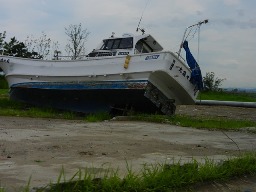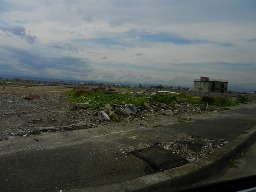 Amidst all the concern about the nuclear failure at Fukushima the plight of the region devastated by the tsunami on 11 March has pretty much disappeared from the international headlines. But the story is still horrifyingly real for those struggling to rebuild their lives and communities. It's been difficult to know at what point to start to make overtures about the opportunities for UK companies to participate in the reconstruction process - we didn't want to get in the way of relief efforts, or appear to be ambulance-chasing. But now that basic services have been restored and recovery is underway we judged that now was the moment to visit and assess the situation. So last week a couple of us from UKTI travelled to Sendai and to the nearby coastal community of Natori to meet local authorities and other organisations involved in reconstruction planning.
Amidst all the concern about the nuclear failure at Fukushima the plight of the region devastated by the tsunami on 11 March has pretty much disappeared from the international headlines. But the story is still horrifyingly real for those struggling to rebuild their lives and communities. It's been difficult to know at what point to start to make overtures about the opportunities for UK companies to participate in the reconstruction process - we didn't want to get in the way of relief efforts, or appear to be ambulance-chasing. But now that basic services have been restored and recovery is underway we judged that now was the moment to visit and assess the situation. So last week a couple of us from UKTI travelled to Sendai and to the nearby coastal community of Natori to meet local authorities and other organisations involved in reconstruction planning.
As we toured the flattened coastal belt of Natori City it looked for all the world like a greenfield construction site, neatly marked out into plots and with orderly piles of what might be mistaken for building materials.It's only on studying the pre-tsunami aerial photos that you realise that until 4 months ago this was a bustling community of 2500 households. ANd only on closer inspection that you realise that the piles are neatly arranged mounds of items for disposal - one of shattered electrical goods, one of mangled car bodies, another of roof tiles. The fishing boats stranded along the roadside 4km from the sea are another clue to what happened, while the few buildings that remain are no more than shells. One, a former community centre, houses trestle tables loaded with photo albums and other personal memories rescued from the debris, waiting to be claimed by their owners. Some may wait a long time - over 1,000 people from the town are either dead or missing.
 And yet when you compare the scene with the photos taken the day after the tsunami you can't help but be humbled by just how much has been achieved already. The roads are clear, and fresh timber has been used to reconstruct the gate to the sacred local shrine. The mountains of sludge and debris which were initially piled up ina ridge 15m high and several hundred meters long, is now reduced to one 50m stretch, the rest having been carted away to disposal sites or dumped at sea. The 10,000 residents who sought shelter in evacuation centres have all been rehoused in safer areas. The city hall staff, helped by academic experts and consultants, have produced a vision for the revived community they would like to create and are seeking public views. They envisage moving all residents to higher ground further from the coast, using land along the coast for fish processing workshops and parkland, and perhaps banks of solar panels to feed a local smart grid.
And yet when you compare the scene with the photos taken the day after the tsunami you can't help but be humbled by just how much has been achieved already. The roads are clear, and fresh timber has been used to reconstruct the gate to the sacred local shrine. The mountains of sludge and debris which were initially piled up ina ridge 15m high and several hundred meters long, is now reduced to one 50m stretch, the rest having been carted away to disposal sites or dumped at sea. The 10,000 residents who sought shelter in evacuation centres have all been rehoused in safer areas. The city hall staff, helped by academic experts and consultants, have produced a vision for the revived community they would like to create and are seeking public views. They envisage moving all residents to higher ground further from the coast, using land along the coast for fish processing workshops and parkland, and perhaps banks of solar panels to feed a local smart grid.
Natori is probably more advanced in its clear-up and forward planning that most other communities. But even they are not really sure how foreign companies might be able to help. With so much to do and such stretched resources there is a real lack of capacity to manage the whole process. The people we spoke to during our trip told us that they were stuck for a reply when asked what they needed. They advised us that if British companies were keen to participate and win business the best approach was to develop a proposal, probably in conjunction with a Japanese company or academic familiar with the area and with the broader vision for reconstruction, and present it to communities for consideration. WIth a concrete plan a community would be better placed to leverage funds, both public and private - at the moment there is a chicken and egg dilemma, with communities not wanting to develop plans without knowing how much funding might be available and central government wanting concrete plans to help them decide how much to make available. Some clear, costed blueprints, could be the key to breaking the logjam.
Certain themes emerge strongly when discussing reconstruction visions: renewable energy, smart grids, increased use of telemedicine, creation of data-centres and other facilities making use of cloud computing. There is interest in what the UK might be able to offer in the way of landscape design for coastal parks, and PFI consultancy as a way of unleashing private funding. But this is not a situation that is likely to produce a nice clear set of specifications and tenders. To win business companies are going to have to be proactive in identifying partners and making some speculative investment up-front. In return there could be huge benefits in terms of establishing credibility, contacts and goodwill in a market that values all these things. And of course a great sense of satisfaction in being able to contribute to recovery from a once-in-a-millenium disaster. If your company would be interested get in touch with us and we'll be glad to help.
Sue Kinoshita
Director, Trade & Investment
Sue.kinoshita@fco.gov.uk
